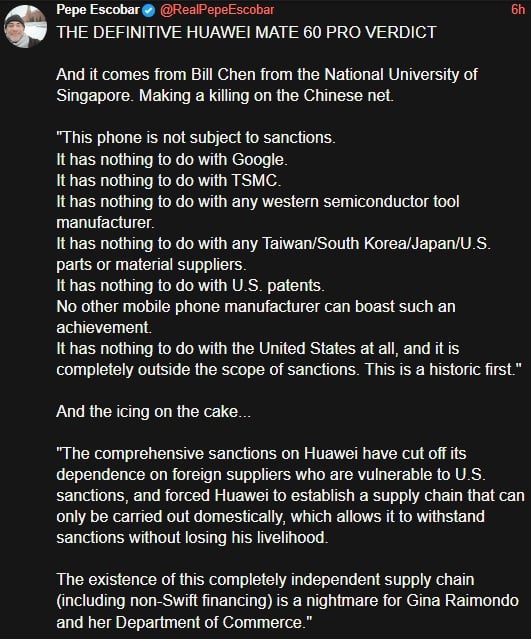this post was submitted on 07 Sep 2023
179 points (92.0% liked)
Technology
963 readers
77 users here now
A tech news sub for communists
founded 2 years ago
MODERATORS
you are viewing a single comment's thread
view the rest of the comments
view the rest of the comments

Let me be the devil's advocate here.
Isn't it using 7nm technology? Isn't that 2018-tech? (https://en.wikipedia.org/wiki/International_Technology_Roadmap_for_Semiconductors)
Is China having the bet tech of six years ago really such a breakthrough?
Not really, if you're looking the actual performance and efficiency numbers. And you have to compare ARM mobile chips with other ARM mobile chips. 7+nm TSMC process was used to make the Snapdragon 865, the flagship processor for 2020 android smartphones. And Huawei's 7nm domestic process comes extremely close to that on efficiency. Huawei's chips are actually slightly more efficient than the Snapdragon 888 and 8 gen 1, which were made on Samsung's 5nm and 4nm process and the flagship processors for the 2021 and 2022 android smartphones (yes, these less efficient than TSMC 7+nm Snapdragon 865 from 2020). Obviously the newer TSMC process that the Snapdragon 8+ gen 1 and 8 gen 2 chips use have much better efficiency.
In terms of single core CPU performance, Huawei is right in between the Snapdragon 865 and 888. And superior to them in multi core performance, as Huawei's Kirin 9000s performance core and big cores are based off of server ARM chips and support hyperthreading. Obviously the 8+ gen 1 and 8 gen 2 are superior in performance.
For Huawei's domestic process to be only 2 to three years behind TSMCs process, the best in the world for ARM chips, is an incredible accomplishment. Especially given all the sanctions.
That is pretty incredible. It seems TSMC, Samsung, and Huawei are the leading edge, right?
Edit: Thanks for the corrections, comrades!
SMIC is the fab that Huawei contracts to make the Kirin 9000S. Huawei has the capability to make most other chips itself just not mobile phone SOCs.
Oh wow that is impressive. I wonder what the power draw is like with them being based on server ARM chips
It absolutely is because they managed to get to this point in only a few years, people were predicting that China would be stuck at 28nm even just a few months ago. Obviously China isn't just going to be sitting still now that they reached 7nm, and they'll likely get to the point where they can make 3nm chips in a few years. Meanwhile, we're reaching the limits of what's possible to do with silicon, and western chip makers are basically hitting that limit already. The way forward after that will be to use a different substrate and it looks like China is making the most progress there as well.
Another thing to note is that majority of chips produced aren't bleeding edge chips. 7nm is good enough for vast majority of applications. As we see with Mate 60, it performs just as well as latest iPhones using the latest and greatest western chips.
Well look at the other contract fabs that could buy EUV scanners if they wanted to.
GlobalFoundries gave up on 7nm so 14/12nm is the best they have. UMC barely makes any 14nm chips so they definitely aren't pursuing anything below 7nm. Getting to 7nm is an investment few can make and it won't pay off for most. The number of fabless chip companies that can afford to design for <7nm and need the leading edge in performance is tiny. A high price of entry to serve so few customers.
SMIC is only the third pure play contract fab to offer <=7nm and Samsung needed EUV to get to 7nm unlike SMIC and TSMC.
Judging by the performance and density of the Kirin 9000S, SMIC's 7nm DUV is at least as good as Samsung's 5nm EUV. The same A510 cores made with SMIC's 7nm are as efficient if not more so than those made with Samsung 4nm.
The previous top Huawei phone, the P60 Pro has the 4G variant of the 8+ Gen 1, which was made with TSMC 4nm. The Mate 60 Pro being technically a downgrade in process node is something few if any of its users will actually notice in practice. Huawei could've easily just made a 5G modem and paired it with an 8 Gen 2. It would've been a lot easier to make a tiny modem yield but they chose the harder option of making an entire SOC. They succeeded in matching if not surpassing the TSMC 5nm made original that stopped being made on September 15, 2020. All the sanctions could do was delay further production of the Kirin 9000 for 3 years.
The latest gen of ryzen the 7000 is using TSMC 5nm on the Compute die and 6nm I/O DIe, and don't forget that intel in 2021 relased their 11th gen of cpu with 14nm
AMD always having the process advantage over Intel and Nvidia but still ending up as the underdog is puzzling.
AMD Zen 2 on 7nm should've destroyed Comet lake on 14nm but it didn't. Rocket Lake faired a lot worse against Zen 3 but it was an iffy 10nm to 14nm port job.
AMD Navi GPUs on 7nm somehow were less efficient than Nvidia's Turing on 12nm(16nm+) while also not having ray tracing or tensor cores. Nvidia were left cocky enough to go for Samsung's discount 8nm the gen after instead of attaining process parity.
It's going to get worse because the gains from each succeeding node diminishes so AMD can no longer count on the gains to make them competitive.